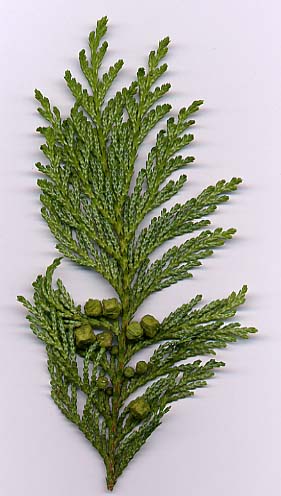Chamaecyparis
| False Cypress | |
|---|---|
 | |
| Genus: | Chamaecyparis |
| Family: | Cupressaceae |
| Type: | Trees and Shrubs |
| Pollination: | Wind pollinated |
Chamaecyparis is genus of conifers in the family Cupressaceae, native to eastern Asia and western and eastern North America. It is one of several genera within the Cupressaceae that have the common name cypress. Synonyms include Retinispora Siebold & Zucc. and Retinospora Carr.
There are a great number of cultivars available among the species with a wide range of shapes, sizes, and leaf colors.
Description
[edit | edit source]They are medium-sized to large evergreen trees growing to 20–70 m tall, with foliage in flat sprays. The leaves are of two types, needle-like juvenile leaves on young seedlings up to a year old, and scale-like adult leaves. The cones are globose to oval, with 8-14 scales arranged in opposite decussate pairs; each scale bears 2-4 small seeds.
Growing conditions
[edit | edit source]Four species (C. lawsoniana, C. obtusa, C. pisifera, and C. thyoides) are of considerable importance as ornamental trees in horticulture; several hundred cultivars have been selected for various traits, including dwarf size, yellow, blue, silvery or variegated foliage, permanent retention of juvenile leaves, and thread-like shoots with reduced branching. In some areas, cultivation is limited by Phytophthora root rot diseases, with C. lawsoniana being particularly susceptible to Phytophthora lateralis.
Species
[edit | edit source]There are five or six species, depending on taxonomic opinion:
- Chamaecyparis formosensis. Taiwan.
- Chamaecyparis lawsoniana. Western North America.
- Chamaecyparis obtusa. Japan.
- Chamaecyparis pisifera. Japan.
- Chamaecyparis taiwanensis. Taiwan.
- Chamaecyparis thyoides. Eastern North America.
C. taiwanensis is treated by many authors as a variety of C. obtusa (as C. obtusa var. formosana).
Another species which used to be included in this genus, as Chamaecyparis nootkatensis, has now been transferred on the basis of strong genetic and morphological evidence to the separate genus Callitropsis as Callitropsis nootkatensis, or back to Cupressus nootkatensis (the name it was originally described under in 1824).
Uses
[edit | edit source]The wood is scented, and is highly valued, particularly in Japan, where it is used for temple construction.
Maintenance
[edit | edit source]Pruning can be done in winter. Most species tolerate shearing and can be grown as hedges or topiaries.
Propagation
[edit | edit source]Cuttings, grafting, or seed.
Pests and diseases
[edit | edit source]- Phomopsis juniperovora
- Seiridium or Coryneum Blight and Canker: Seiridium cardinale
- Phytophthora lateralis Problem in Pacific Northwest.
- Phytophthora cinnamomi
- Witches Broom (Rust): Gymnosporangium ellisii, Alternate hosts in Myrica and Comptonia
- Spindle Burl Gall (Rust): Gymnosporangium biseptatum, Alternate host in Amalanchier
- Juniper Scale: Carulaspis juniperi
- Arborvitae Weevil: Phyllobius intruscus
- Imperial Moth: Eacles imperiales
- Bagworm: Thyridopterix ephemeraeformis
- Spruce Spider Mite: Oligonychus ununguis
Chamaecyparis species are used as food plants by the larva of some Lepidoptera species including w:Juniper Pug and w:Pine Beauty.
References
[edit | edit source]- Gymnosperm Database: Chamaecyparis
- Flora of China: Chamaecyparis
- Flora of North America: Chamaecyparis
- Germplasm Resources Information Network: Chamaecyparis
- Farjon, A. (2005). Monograph of Cupressaceae and Sciadopitys. Royal Botanic Gardens, Kew. ISBN 1-84246-068-4.
- Hwang, S.-Y., Lin, H.-W., Kuo, Y.-S., & Lin, T.-P. (2001). RAPD variation in relation to population differentiation of Chamaecyparis formosensis and Chamaecyparis taiwanensis. Bot. Bull. Acad. Sin. 42: 173-179. Available online (pdf file).
- Christopher Brickell and Judith D. Zuk (1997). The American Horticultural Society A-Z Encyclopedia of Garden Plants. DK Publishing. pp. 262–254.
- Staff of the L. H. Bailey Hortorium (1976). Hortus Third: A Concise Dictionary of Plants Cultivated in the United States and Canada. Cornell University Press. pp. 254–255.
- Pirone, Pascal P. (1978). Diseases & Pests of Ornamental Plants (Fifth Edition ed.). John Wiley & Sons, New York. pp. 191–192.
{{cite book}}:|edition=has extra text (help) - Cranshaw, Whitney (2004). Garden Insects of North America: The Ultimate Guide to Backyard Bugs. Princeton University Press. p. 587.
- Pippa Greenwood, Andrew Halstead, A.R. Chase, Daniel Gilrein (2000). American Horticultural Society Pests & Diseases: The Complete Guide to Preventing, Identifying, and Treating Plant Problems (First Edition ed.). Dorling Kindersley (DK) Publishing, inc. p. 102.
{{cite book}}:|edition=has extra text (help)CS1 maint: multiple names: authors list (link)